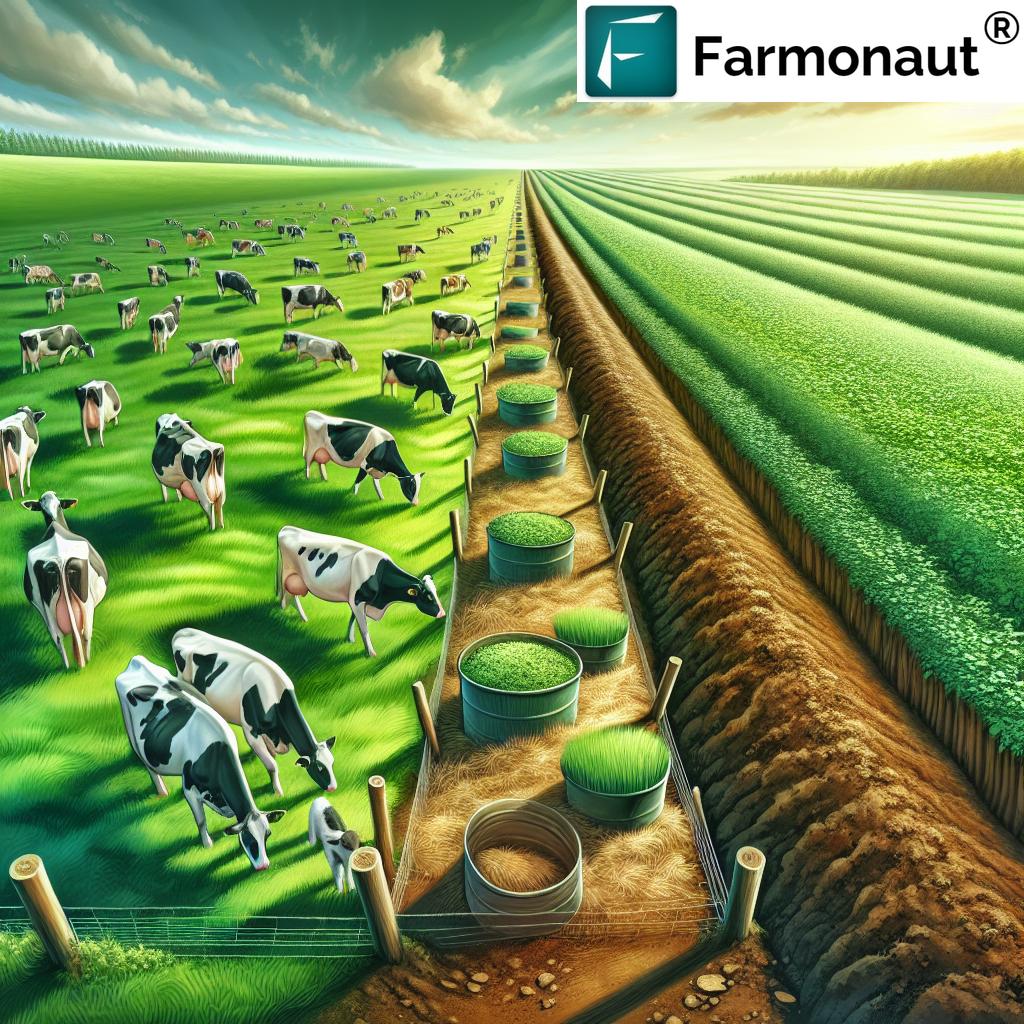Table of Contents
- Introduction: Elevating Nutrient Management in 2025
- Trivia: Impact of Soil Carbon
- Essentials of Adding Nutrients to Soil & Hydroponics
- Critical Aspects of Adding Nutrients to Soil
- Adding Nutrients to Hydroponics: The 2025 Approach
- Nutrient Application Comparison Table (Soil vs. Hydroponics)
- Adding Acid to Soil & Managing Acidity: Modern Practices
- Adding Carbon to Soil: Cornerstone of Climate-Smart Agriculture
- Integrated Nutrient, pH, and Carbon Management Strategies
- Farmonaut’s Satellite Solutions for Sustainable Agriculture
- Trivia: Hydroponic pH Management Boosts Efficiency
- Key Resources, Apps & Solutions for 2025
- Frequently Asked Questions (FAQ)
- Conclusion: Pathways to Sustainable, Productive Farming
- Farmonaut Subscription – Start Monitoring Today
Adding Nutrients to Soil & Hydroponics: 2025 Guide
Meta Description:
Enhance food yields sustainably in 2025 by adding nutrients to soil and hydroponics. Explore essential nutrient, acidity, and carbon management practices for agricultural health and climate.
Summary:
Optimizing soil and growing media nutrient profiles is now a non-negotiable for sustainable agriculture, especially as we look ahead to 2025 and beyond. With intensifying global agricultural challenges, the need to improve soil and media health—by adding nutrients to soil, managing acidity levels, and increasing soil carbon content—has never been more critical to delivering sustainable food production, protecting ecosystem health, and mitigating climate change impacts.
In this comprehensive guide, we explore the essentials of nutrient addition in both soil and hydroponic systems, practices for managing pH, and advances in carbon retention. We also highlight how technology-driven, environmental solutions—especially those offered by Farmonaut—are helping farmers, growers, and businesses optimize yields and stay sustainable.
“Soil carbon increase by 1% can boost crop yields by up to 12% sustainably.”
Essentials of Adding Nutrients to Soil & Hydroponics in 2025
Modern agriculture is the backbone of global food security. As resource challenges intensify, the focus in 2025 must be on adding nutrients to soil and growing media, maintaining pH for optimal nutrient availability, and improving carbon levels for resilient yields and environmental balance.
Agricultural sustainability depends on an integrated approach: balancing inputs with natural processes, minimizing waste, and harnessing innovations—ranging from real-time sensor technologies to advanced analytics.
- Essential macronutrients: Nitrogen (N), Phosphorus (P), Potassium (K)
- Critical micronutrients: Zinc (Zn), Iron (Fe), Manganese (Mn)
- Modern strategies: Use of both organic (e.g., compost, biochar) and synthetic fertilizers tailored through precision management for optimal results
- Monitoring & Adjustment: Incorporate pH sensors, adaptive data analytics, and AI-driven technologies
In hydroponics, where soil is replaced by formulated nutrient solutions, maintaining nutrient concentration and acidity profiles is vital to foster plant health and growth. Automated dosing and constant monitoring define the new standard.
Critical Aspects of Adding Nutrients to Soil
The foundation lies in soil health: In soil-based agriculture, balancing the input of nutrients is critical. Macronutrients and micronutrients must be delivered in forms and timings that match crop requirements. Nutrient deficiencies or surpluses can impede yield, upset microbial activity, and harm environmental health.
How Are Nutrients Added to Soil?
- Organic Amendments:
- Compost: Releases a spectrum of nutrients slowly, improves soil structure, and enhances carbon retention and microbial activity.
- Biochar: Boosts nutrient- and water-holding capacity, supports carbon sequestration, and stabilizes soil pH.
- Green manure and cover cropping: Fixes nitrogen and builds organic matter, adding acidity in certain cases and driving beneficial changes in the soil profile.
- Synthetic Fertilizers:
- Engineered to deliver major nutrients like N, P, K in predictable concentrations.
- Now often applied via precision agriculture—using soil maps, satellite data, and remote sensors to optimize input rates and timings with greater accuracy.
- Micronutrients (like Zn, Fe, Mn) added via foliar sprays or soil amendments, with adjustments based on real-time deficiencies detected by sensor networks and AI advisories.
- Monitoring & Management: Advanced soil testing enables tailored management. We recommend reviewing carbon footprinting solutions for evaluating the environmental impact of inputs.
Sustainable Nutrient Addition: Best Practices
- Split applications: Reduces losses through leaching and runoff, especially important for nitrogen.
- Integrated soil health monitoring: Use satellite and in-field sensors to identify spatial nutrient variability—this is where Farmonaut’s real-time monitoring platform excels, offering data-driven recommendations for crop nutrition and environmental management.
- Precision targeting: Tailor amendment types, rates, and placement according to crop stage, weather patterns, and historical soil data.
Adding Nutrients to Hydroponics: The 2025 Approach
Hydroponics is a rapidly expanding sector in global agriculture, especially in regions grappling with soil degradation, limited water, and urbanization pressures. In hydroponic systems, all essential nutrients are supplied directly to plants via formulated solutions—bypassing soil entirely.
Key Nutrient Management Aspects in Hydroponics
- Nutrient solution formulation: Designed to precisely match plant species and development stage. Balances all major macronutrients (N, P, K) and critical micronutrients (zinc, iron, manganese, etc.) for optimal uptake.
- Precise pH control: Managing acidity is vital—every plant species has an ideal pH range, and nutrient availability changes dramatically with even small pH shifts. Automated sensors and AI-driven platforms in 2025 enable continuous feedback and adjustment.
- Automated dosing: Advanced dosing systems automatically adjust nutrient concentrations and acidity based on real-time data inputs, minimizing waste and runoff.
- Resource efficiency: Hydroponic recycling systems reduce water and nutrient loss, minimizing environmental impacts and reducing farming inputs.
Tip: Using large-scale farm management platforms with built-in hydroponic solution monitoring helps aggregate data, streamline feeding schedules, and optimize input-to-yield ratios for growers and businesses.
Advantages of Hydroponic Nutrient Strategies in 2025
- Year-round production: Controlled environments eliminate seasonality issues and support consistent yields.
- Higher water-use efficiency: Up to 90% less water than conventional soil agriculture.
- Reduced environmental impact: Controlled application and recycling cuts nutrient waste and pollution.
Nutrient Application Comparison Table (Soil vs. Hydroponics)
| Nutrient Name | Soil Application Method (2025 Est.) | Hydroponic Application Method (2025 Est.) | Recommended pH Range | Est. Yield Increase (%) | Environmental Benefit |
|---|---|---|---|---|---|
| Nitrogen (N) | Split urea/DAP application or organic compost (75–200 kg/ha) | 150–200 ppm via automated dosing, recirculated/monitored | Soil: 6.0–7.5; Hydroponics: 5.5–6.5 | 12–18% | Reduced runoff, enhanced microbial activity |
| Phosphorus (P) | Triple superphosphate, bone meal, or compost (30–60 kg/ha) | 30–50 ppm, continuous monitoring, chelated forms | Soil: 6.5–7.0; Hydroponics: 5.8–6.2 | 10–15% | Prevents water pollution, supports root health |
| Potassium (K) | Muriate of potash, wood ash, compost (50–80 kg/ha) | 150–180 ppm, automatic potassium nitrate dosing | Soil: 6.0–7.5; Hydroponics: 5.5–6.5 | 8–15% | Improved drought resilience & quality |
| Zinc (Zn) | Soil chelates, foliar sprays (10–25 kg/ha) | 0.1–0.5 ppm, soluble solution | Soil: 6.0–7.5; Hydro: 5.5–6.0 | 5–10% | Essential for micronutrient balance, low toxicity |
| Iron (Fe) | EDTA chelates, ferrous sulfate, compost (10–25 kg/ha) | 1–2 ppm, chelated/monitored solutions | Soil: <6.5; Hydroponics: 5.5–6.0 | 8–15% | Prevents chlorosis, improves photosynthesis |
| Manganese (Mn) | Soil chelates, organic amendments (5–15 kg/ha) | 0.2–0.6 ppm, added with pH control | Soil: 6.0–7.0; Hydroponics: 5.5–6.2 | 6–10% | Supports microbial health, boosts quality |
| Boron (B) | Borax, organic compost (1–2 kg/ha) | 0.1–0.3 ppm, controlled delivery | Soil: 6.0–7.0; Hydroponics: 5.5–6.0 | 2–5% | Vital for flowering & fruiting; low risk of contamination |
| Calcium (Ca) | Gypsum, lime, dolomite (20–40 kg/ha) | 120–200 ppm, as calcium nitrate | Soil: 6.5–7.5; Hydroponics: 5.8–6.2 | 6–12% | Improves cell strength; mitigates acidic stress |
Adding Acid to Soil & Managing Acidity: Modern Practices
Soil pH is a crucial control point in nutrient management. Soil can naturally become too alkaline or acidic depending on parent material, climate, irrigation practices, and amendment history. However, for optimal crop production, most soils should be in the 6.0–7.0 pH range. Acidic (low pH) soils inhibit uptake of phosphorus, calcium, and magnesium, while alkaline (high pH) soils often restrict iron, zinc, and manganese uptake.
- Why Add Acid to Soil?
Regions with naturally alkaline soils or excessive use of lime may require adding acid to soil to adjust pH. This adjustment improves nutrient solubility and facilitates uptake, directly boosting yields and environmental health. - Common Acidifying Inputs:
- Elemental sulfur: Microbial conversion produces sulfuric acid, gradually decreasing pH.
- Ammonium sulfate and acid-forming fertilizers: Deliver nitrogen and lower soil pH through decomposition.
- Organic acids (from compost/green manure): Help correct moderate alkalinity—great for adding acidity to soil sustainably.
Best practices in 2025: Application timing and rates are increasingly informed by real-time soil pH sensors and smart analytics platforms. This adaptive management significantly reduces the risk of over-acidification, which could impair beneficial soil organisms and long-term soil health.
Monitoring & Managing Acidity in Growing Media
- Regular pH testing using handheld or in-field sensors, connected to data management apps
- Adjustments made by adding acid or alkaline amendments as needed, always with real-time data access to support decisions
- Leverage platforms such as Farmonaut for comprehensive monitoring across multiple fields or facilities, ensuring accurate and timely intervention
Curious about tracking acidity, carbon, and nutrient levels at scale? Our carbon footprinting and traceability tools help agricultural businesses monitor and document sustainability performance.
Adding Carbon to Soil: Cornerstone of Climate-Smart Agriculture
The role of carbon in soil health, structure, and productivity is now central to environmental and sustainable farming discussions.
Adding carbon to soil improves physical properties, water retention, and nutrient cycling while sequestering atmospheric carbon—directly impacting climate mitigation.
Best Practices for Enhancing Soil Carbon Content
- Compost application: Increases organic matter, stimulates microbial activity, and boosts carbon retention.
- Biochar incorporation: Biochar is a stable form of carbon produced from biomass pyrolysis. It enhances nutrient retention and supports resilient crop growth.
- Cover cropping & green manure: Diverse cover crops fix nitrogen, break disease cycles, and return large quantities of carbon to soil upon decomposition.
- Reduced tillage: Minimizing disturbance preserves carbon stocks, improves soil structure, and reduces erosion.
Curious about monitoring your carbon footprint? Explore Farmonaut’s carbon monitoring solutions for actionable, satellite-based metrics.
Environmental & Yield Co-Benefits
- Enhances water retention and drought resistance
- Improves soil structure for root expansion and healthy microbial populations
- Contributes to climate change mitigation by storing carbon in the ground
- Reduces atmospheric greenhouse gas emissions and supports ecosystem resilience
Integrated Nutrient, pH, and Carbon Management Strategies
In 2025, the intersection of technology and sustainable farming is clear: adopting integrated strategies is now essential to achieve optimal food production, enhanced environmental health, and climate resilience.
- Site-specific management: Leverage real-time soil health data, nutrient maps, and pH monitoring to adjust nutrient and amendment input rates with precision.
- Data-driven decision-making: Combining human knowledge and AI analytics, farmers receive actionable, field-specific advice—from recommended fertilizer blends to acidification schedules.
- Resource efficiency: Reduce input use, minimize losses, and avoid environmental waste (leaching/runoff) via advanced monitoring and customized solutions.
With our satellite-driven large-scale farm management platform, multi-location operators, and agribusinesses can monitor site-specific nutrient levels, pH deviations, and carbon sequestration status from a single dashboard.
“Optimal pH management in hydroponics can improve nutrient uptake efficiency by 30% in 2025 systems.”
Optimizing Crop Production With Technology
- Remote Sensing (via Farmonaut): Satellite-based monitoring enables us to quickly identify nutrient deficiencies, pH imbalances, or deteriorating soil carbon without manual inspections.
- Jeevn AI Advisory System: Real-time AI-powered coaching for tailored strategies—reducing operational risks and improving planning accuracy.
- Blockchain Traceability: Prove and maintain input accuracy for conscious consumers and regulators with Farmonaut’s traceability solutions.
- Resource Tracking: Manage fleets, input usage, and emissions efficiently using Farmonaut fleet management tools.
Farmonaut’s Satellite Solutions for Sustainable Agriculture
At Farmonaut, our mission is to empower business, government, and individual users to adopt technology-driven sustainability practices for thriving, future-proof agriculture and natural resource management. We believe integrated solutions will underpin resilient food systems in 2025 and beyond.
Farmonaut Platform Features for Nutrient & Soil Management
- Real-Time Crop & Soil Monitoring: Access NDVI, soil moisture, and crop condition insights on Android, iOS & Web Apps. Empower timely interventions to correct deficiencies or imbalances and reduce input waste.
- Carbon Footprint Monitoring: Track emissions, analyze soil carbon content, and assess the impact of your nutrient amendment strategies on climate health in your fields.
- API Integration: Connect satellite, AI, and environmental monitoring directly to your farm’s dashboard (with Developer Docs).
- Resource & Fleet Management: Log and track usage of fertilizers and amendments to minimize environmental waste.
- AI-Driven Advisory: Jeevn AI system helps you, as a grower or agribusiness, receive field-specific nutrient, pH, and carbon insights—maximizing crop health and minimizing costs.
For those seeking end-to-end agricultural oversight, our crop, plantation & forest advisory app provides a modular toolkit—perfect for managing nutrient balancing in both soil and hydroponic operations, optimizing resource use, and ensuring regulatory compliance.
Key Resources, Apps & Solutions for 2025
- Carbon Footprinting Solution: Evaluate your farm’s emissions, monitor soil carbon stocks, and document sustainability progress using state-of-the-art satellite analytics.
- Fleet Management: Minimize input waste through smart logistics and precision tracking for machinery and field activities.
- Product Traceability: Build trust and prove input quality for your food, feed, or resource supply chains—leverage blockchain for unmatched transparency.
- Crop Loan & Insurance Verification: Speed up financing and risk assessment with satellite-based yield monitoring and compliance verifications.
- Developers & API Integrations: Unlock advanced data insights—connect nutrient, pH, and carbon content data to your in-house dashboards (Docs).
Frequently Asked Questions (FAQ) – Nutrient Addition & Sustainable Agriculture in 2025
Q1: Why is adding nutrients to soil more important in 2025?
As agriculture faces global resource and climate challenges, optimal nutrient management is critical to boosting crop yields, maintaining soil health, and minimizing environmental impact. Advances in monitoring, technology, and analytics make site-specific, sustainable addition of nutrients to soil the cornerstone of resilient food production.
Q2: How does pH influence nutrient uptake?
Soil or hydroponic solution pH affects the availability of essential nutrients. Most crops thrive with soil pH between 6.0–7.0; acidic or alkaline conditions can inhibit uptake of phosphorus, calcium, iron, and other micronutrients, hampering yield and plant health.
Q3: What’s the sustainable way to add nutrients to hydroponics?
The best practice involves carefully formulated, balanced nutrient solutions, automated dosing, real-time pH and EC monitoring, and recycling water to minimize waste—focusing on continuous adjustments for optimal plant health in controlled environments, all while using the least amount of inputs.
Q4: Can increasing soil carbon content really boost yields?
Yes—a 1% increase in soil organic carbon can sustainably increase yields by up to 12%. More carbon improves nutrient cycling, water retention, plant resilience, and helps sequester atmospheric carbon for climate mitigation.
Q5: How often should I monitor soil nutrients and pH?
In 2025, real-time or high-frequency monitoring using satellite technology, in-field sensors, or mobile apps is standard. Regular assessment allows adaptive management and helps prevent both deficiencies and wasteful over-application.
Q6: What Farmonaut tools can help me with nutrient & carbon management?
Farmonaut’s satellite apps and platforms enable real-time monitoring of nutrient status, soil moisture, crop vigor, pH deviations, and even carbon content—supporting targeted, sustainable agricultural decisions.
Conclusion: Pathways to Sustainable, Productive Farming
In summary, adding nutrients to soil, expertly managing pH, and adding carbon to soil are the linchpins of climate-resilient, sustainable agriculture in 2025 and beyond. Breakthroughs in monitoring, analytics, and integrated management platforms—especially those leveraging satellite, AI, and blockchain—empower farmers, agribusinesses, and governments to optimize yields while stewarding environmental health.
For ongoing productivity and sustainability in both soil-based and hydroponic systems, now is the time to:
- Adopt advanced, precision-based nutrient addition and management practices
- Continuously monitor pH and nutrient content with modern technology
- Integrate practices to boost carbon retention—through compost, biochar, and reduced tillage
- Explore satellite-powered, real-time monitoring and advisory solutions on platforms like Farmonaut for seamless, data-driven agricultural decisions
Ready to ensure optimal nutrient, acidity, and carbon balance for your crops?
Start your journey with Farmonaut’s monitoring solutions and download our free apps to experience the future of environmentally-conscious, resilient agriculture.
Farmonaut Subscription – Start Real-Time Nutrient Monitoring Today!
Unlock affordable, satellite-based crop, field, and nutrient monitoring for your farm, business, or government operation. Explore plans suited for all scales and start optimizing your soil and hydroponic nutrient profiles now.














